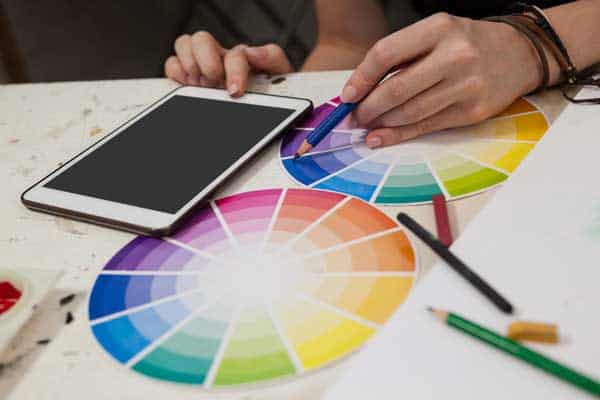Color is an extremely influential, yet often overlooked element that plays a critical role in marketing. Color psychology explores how different colors affect human perception and decision making in powerful ways that marketers can utilize.
In this article, we will examine various colors and the psychology behind them to help you better target audiences and influence behavior through your marketing campaigns and branding.

The Meaning and Impact of Blue in Branding
The color blue promotes a sense of trust, security and reliability. That is why blue is the color choice for brands that want to convey strength, expertise and professionalism. Blue evokes feelings of calmness and stability, making it an ideal color for social media platforms like Facebook and Twitter that want users to connect comfortably with friends and share openly.
Major companies rely heavily on different shades of blue in their branding and websites including healthcare networks, technology companies, airlines, banks and insurance providers. American Express and IBM both utilize blue logos to align with their images of dependability and professional authority.
Yellow Sparks Feelings of Happiness and Energy
The bright and sunny color yellow commands attention by stimulating the memory and encouraging communication. Associated with joy and optimism, yellow boosts positivity, sparks imagination and builds confidence. That is why many fast food brands like McDonald’s and Subway integrate yellow prominently in their advertising and restaurants to stimulate appetite and help create an upbeat, family-friendly dining experience.
Companies across industries enliven their brands with splashes of yellow to convey happiness, hope and positivity. Post-It leverages a vibrant yellow branding that reflects the uplifting, creative spirit their products aim to inspire. Yellow is also connected to freshness and clarity, making it an ideal accent color for brands marketing eco-friendly or cleaning products.
Green Promotes Natural, Organic Vibes
The color green evokes a strong association with nature, health and renewal. Often used to promote environmental causes, organic foods and wellness products, green branding can help strengthen perceptions of trust and safety. Food and beverage companies often integrate green packaging or elements into product lines touting natural, sustainable or healthy positioning to tap into positive green perceptions.
Vibrant green shades also represent growth, making green a fitting representative color for agribusinesses, gardening brands and financial institutions seeking to convey prosperity and stability. Green’s association with freshness can also prove effective for education and technology companies aiming to convey forward-thinking, innovative positioning.
Black and White Convey Luxury Appeal
Black commands a powerful, luxurious presence across luxury fashion, cosmetics, technology, automobile and other high-end industries. Associated with sophistication and exclusivity, black signals elite status and style. Tech giant Apple leverages black branding to align their products with cutting-edge innovation and premium artistry. Adding black packaging or displays helps beauty brands and retailers establish an upscale ambiance that attracts affluent audiences.
Crisp, clean white expresses purity and simplicity. White branding helps evoke feelings of safety and softness. Fast food restaurants, healthcare facilities and self-storage companies often apply white prominently to convey cleanliness. White also embodies modernity and space, making it a popular tech and appliance color. All-white interior design and packaging communicates cool, contemporary appeal for modern brands targeting youthful demographics.
Conclusion
This exploration of color psychology reveals how different colors influence human emotion and decision making in subconscious yet significant ways. By utilizing color strategically in your branding, product packaging, advertising and other marketing touchpoints, you can attract your target buyer’s attention while conveying specific lifestyle feelings that resonate powerfully with them on an emotional level to drive action. Focus on colors that reflect attributes you want associated with your company brand and products to shape positive perceptions that prompt leads and customers to engage further.

